

Seabed Mining and Approaches to Governance of the Deep Seabed. Introduction Seabed mining was first mooted in the 1960s, when John L.
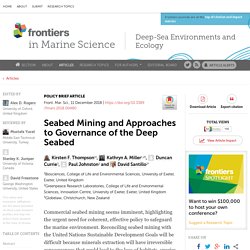
Mero implied in his 1965 book, ‘Mineral Resources of the Sea’, that manganese nodules grow so fast that the supply would be inexhaustible (Glasby, 2000). Research shows that those estimations were incorrect: marine minerals such as manganese nodules grow at a rate of just several mm to cm per million years (Halbach et al., 1980; Gollner et al., 2017).
Commercial seabed mining to target these and other slow-growing deep-sea mineral deposits is now a real possibility. Why massive effort needs to be put into growing trees on farms. It’s now over 50 years since the world was first warned that resources were being used at an unsustainable rate.
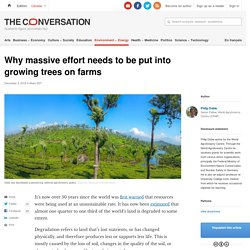
It has now been estimated that almost one quarter to one third of the world’s land is degraded to some extent. Degradation refers to land that’s lost nutrients, or has changed physically, and therefore produces less or supports less life. This is mostly caused by the loss of soil, changes in the quality of the soil, or changes to land cover – like trees being cut down. About 20% of agricultural land and 40% of forests are degraded. Degradation reduces our capacity to feed a world population that will reach at least 9 billion people by 2050 and it destroys ecosystem services – like the supply of clean water.
How to Convert Climate-Changing Carbon Dioxide into Plastics and Other Products. Rutgers scientists have developed catalysts that can convert carbon dioxide – the main cause of global warming – into plastics, fabrics, resins and other products.
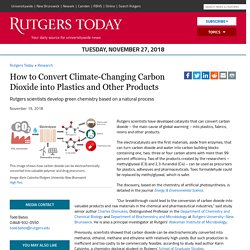
The electrocatalysts are the first materials, aside from enzymes, that can turn carbon dioxide and water into carbon building blocks containing one, two, three or four carbon atoms with more than 99 percent efficiency. Two of the products created by the researchers – methylglyoxal (C3) and 2,3-furandiol (C4) – can be used as precursors for plastics, adhesives and pharmaceuticals. Toxic formaldehyde could be replaced by methylglyoxal, which is safer. The great African regreening: millions of 'magical' new trees bring renewal. Rain had come to nearby villages, but not yet to Droum in south-east Niger.

The sand under its stately trees looked completely barren, but Souley Cheibou, a farmer in his 60s, was not worried. He crooked a finger, fished in the sand, and brought out a millet seed. In a week or two, this seed would germinate and sprout, and soon the whole field would be green. Cheibou’s peace of mind stemmed from the trees encircling him, which had been standing long before he was born. Can we remove a trillion tons of carbon from the atmosphere? 'Remove', 'sequester', 'lock-up'.
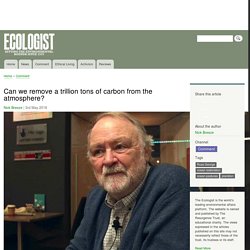
Call it how you like, but to stabilise our climate and surpass the Paris Agreement, we really need to be thinking about storing hundreds of billions of tonnes of carbon. I don’t think anybody on Earth can visualise what numbers like these really look like. Yet, our future depends on us lowering the quantity of greenhouse gases in the atmosphere to safe levels before, so-called self-amplifying feedbacks take over - if they haven’t already. There is a clue emerging as to how we might accomplish such a feat - in the image of the Blue Marble NASA image of Earth. Namely that over 70 percent of the planet is ocean and the fate of life on Earth is intrinsically tied to that of the oceans.
Can we remove a trillion tons of carbon from the atmosphere? Coming to a plate near you soon? Rice grown by Chinese scientists using seawater in Dubai’s deserts. Chinese scientists have successfully grown and harvested rice in the deserts of Dubai after developing a strain that allows the crop to grow in saltwater.

A team of scientists, led by China’s “father of hybrid rice” Yuan Longping, has already started growing the crop in diluted sea-water at home and is now bringing the technique to the Middle East, where fresh water is too precious to use for growing water-intensive crops. Last week’s rice harvest, which had been planted in January on the outskirts of the city, far exceeded scientists’ expectations, according to a report by the state news agency Xinhua. The high yield reported – 7,500kg per hectare compared with the global average of 3,000kg per hectare – has encouraged scientists to expand the project. For clean drinking water in Kenya, just add sunshine (and a ... "There is nothing that makes any woman happier" By Dominic Kirui EMUCHIMI, Kenya, Feb 22 (Thomson Reuters Foundation) - On a sunny afternoon in Western Kenya, Eunice Shigali filled a jerrycan with water, then unfolded it like a suitcase and placed it in the sun.
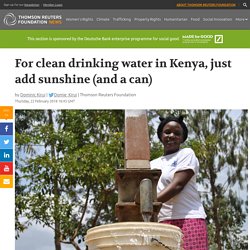
Why prairies matter and lawns don’t. Prairies – those critically endangered and complex ecosystems understood by few and misunderstood and destroyed by millions of people.
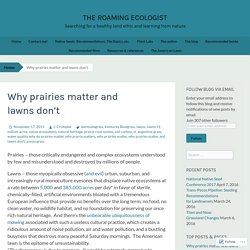
Cheap Drinking Water From The Sun, Aided By A Pop Of Pencil Shavings : Goats and Soda. Solar sponge: The top layer of graphite soaks up the sun's energy in tiny holes.
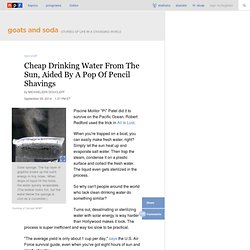
When drops of liquid fill the holes, the water quickly evaporates. Building resilience within economies: new report by SABMiller and WWF. Decisions made early on about infrastructure and institutions which govern industry have implications for ensuring resilience later on.

Photograph: Fabian Bimmer/REUTERS Whether you're a farmer in Tanzania, a government minister in Uttar Pradesh or a captain of industry in the UK, good stewardship of water, food and energy resources underpins development. Today, as the assembled leaders of governments, NGOs and business in Davos focus on the future of the global economy, we provide new insights that can help them to plan for development which is resilient to the great global changes of the 21st Century. Companies proclaim water the next oil in a rush to turn resources into profit. “Is now the time to buy water?” Enquired the email that showed up in my inbox earlier this week. Fly farm aims to create buzz. The 8500m² undercover facility, which is being built by Gibraltar-based AgriProtein, will be completed next year and aims to produce 23.5 metric tons of insect-based protein meal and oils and 50 tons of fertiliser a day.
Fish and chicken farmers have already signed contracts to buy the feed, an alternative to soy and fishmeal, according to Jason Drew, the company's co-founder. Aspire - Amathole Beyond Limits. Grey Water Information Central. What is grey water? Any washwater that has been used in the home, except water from toilets, is called grey water. Dish, shower, sink, and laundry water comprise 50-80% of residential "waste" water. Www.rhdhv.co.za/media/201210/NSGC/Appendix G - Nkandla Feasibility Report - Executive Summary and Supporti~1.pdf. Vast freshwater reserves found beneath the oceans. Dec. 8, 2013 — Scientists have discovered huge reserves of freshwater beneath the oceans kilometres out to sea, providing new opportunities to stave off a looming global water crisis. A new study, published December 5 in the international scientific journal Nature, reveals that an estimated half a million cubic kilometres of low-salinity water are buried beneath the seabed on continental shelves around the world.
The water, which could perhaps be used to eke out supplies to the world's burgeoning coastal cities, has been located off Australia, China, North America and South Africa. Pilot Plant That Converts Carbon Dioxide into Bricks is a World First. Image via Shutterstock A new pilot plant recently launched in Australia aims to combat global warming by converting carbon dioxide into bricks. The culmination of over six years’ effort by The University of Newcastle, the chemical company Orica, and GreenMag Group, the groundbreaking new facility could close carbon loops and divert the greenhouse gas from the atmosphere.
When it comes to global warming, human beings are stuck between a rock and a hard place. On one hand, greenhouse gasses are inevitably pumped into the atmosphere through industry, power generation, and natural processes. Www.eugcc-cleanergy.net/LinkClick.aspx?fileticket=pNru9_ouRzQ=&tabid=296&mid=1026. Myths and Mining: The reality of resource governance in Africa. There are two economic realities on the African continent today. You will find the first one in World Bank, IMF and Africa Development Bank reports – and in articles across the globe about ‘Africa Rising’. The Age of Sustainable Development.
Www.dst.gov.za/images/ska/Bioeconomy Strategy.pdf. Plastic Bank: Harvesting Waste Plastic to Reduce Poverty Through 3D Re-purpose Center for Social Plastic & Ocean Bound Plastic. Waste seashells can solve waste water problem. En/PublicationsLibrary/ditcted2012d3_en. The Sinister Monsanto Group: ‘Agent Orange’ to Genetically Modified Corn. The future of farming: GM crops on organic farms fertilised by human excrement - News releases - News. Humanure Handbook: Contents. Existing cropland could feed 4 billion more. In many areas (lighter areas), crops used for non-food uses (biofuels, other) were not delivered to the food system. Credit: Emily S Cassidy et al. /Environmental Research Letters Reallocating croplands away from fuels and animal feed could boost food available for people by 70 percent without clearing more land, new research from the Institute on the Environment at the University of Minnesota research shows.
Wave goodbye to global warming, GM and pesticides. Updated 25 August 2013 09:56 AM. Project X. Plants slow climate change by forming cloud sunshade: study. Global warming caused by CFCs, not carbon dioxide, study says. Public release date: 30-May-2013 [ Print | E-mail | Energy: Choices made in government's IRP2010 need to be revisited. The recent difference of opinion between the national planning commission (NPC) and the department of energy raises some interesting points for discussion with regards to the energy sector in South Africa.
While the department's energy policy and planning head Ompi Aphane may feel that the NPC researchers do not have the full view of what is happening in government, they certainly do have a much broader, intersectoral approach to energy provision and management than we have seen in department of energy sponsored plans like the integrated resource plan of 2010. Carbon tax to earn R8-billion a year. South Africa committed in 2009 to reduce its carbon emissions by 34% by 2020. Every government department was then told to do its part, and treasury chose a carbon tax. Www.inbar.int/2012/11/bamboo-a-new-approach-to-carbon-credits/ The Limits of the Earth — Part 1: Problems. The Limits of the Earth — Part 2: Expanding the Limits. The Ocean Cleanup - Boyan Slat. How the oceans can clean themselves: Boyan Slat at TEDxDelft.
Study: Drought may be the ‘new normal’ Portable Solar Desalination 'Plant' That May Aid In Third World Water Woes. Nano-scientists develop new kind of portable water purification system. Seawater Greenhouse. Vi~aqua - Water Energising Technology. Urban Resilience. A Once-Polluted Chinese City Is Turning from Gray to Green by Christina Larson. Urban Vegetation Cleans Air Better Than Previously Thought. About Livingroofs.org & Living Roofs. Waste water harnessed to make electricity and plastics - tech - 03 September 2012. Is the end of cheap food just an agricultural problem. Supreme Court To Hear Monsanto Seed Dispute. Stimulating the rural economy. Transfer tribal land to individuals: Agri SA. African farmers must do more to beat climate change: study.
Farmers could become extinct: Agri SA. Barefoot College. The Barefoot_Approach.pdf. Www.grida.no/files/activities/greeneconomy/case-studies-da-india.pdf. Asia Now Blog » Barefoot College. Marcin Jakubowski: Open-Sourced Blueprints For Civilization. Open Source Ecology. Aluminum Extraction From Clays. Aluminum from clay: two processes developed by the bureau of standards - Journal of Chemical Education (ACS Publications and Division of Chemical Education) Www.kau.edu.sa/Files/320/Researches/54693_25008.pdf. INTRODUCING A NEW INDUSTRY. - SCIENTIST'S INVENTION FOR EXTRACTING ALUMINIUM FROM CLAY. - View Article.
Open Source Aluminum from Clay. Seed Factories. When Low-Tech Goes IKEA. Online marketplace set to launch local food vendors into the mainstream. Zero Emissions Research Initiatives. Gunter Pauli - Blue economy. …7 POINTS AGENDA ON GREEN ECONOMY FOR SUSTAINABLE DEVELOPMENT. Shaw.asp. Global change: Delivering on Earth's promise. Bianca Jagger: 'The Future We Want' Bianca Jagger: COP18 Failed to Turn Down the Heat.
Carbon debate heats up. China takes a huge step in reducing carbon emissions. Cost of combating climate change surges as world delays: study. Green economy: Humanity's long, slow suicide. Global carbon trading system has 'essentially collapsed' Carbon tax will motivate change. Carbon tax shoots itself in the foot. Desert 'carbon farming' to curb CO2. Bamboo: A new approach to carbon credits. EU parliament support grows for carbon market rescue: climate boss. SA infrastructure going green.